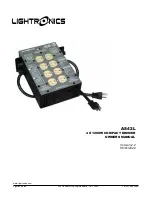
12 ENGLISH
Overdischarge protection
When the battery capacity is not enough, the tool stops
automatically. In this case, remove the battery from the
tool and charge the battery.
Protections against other causes
Protection system is also designed for other causes
that could damage the tool and allows the tool to stop
automatically. Take all the following steps to clear the
causes, when the tool has been brought to a temporary
halt or stop in operation.
1. Turn the tool off, and then turn it on again to
restart.
2. Charge the battery(ies) or replace it/them with
recharged battery(ies).
3. Let the machine and battery(ies) cool down.
If no improvement can be found by restoring protection
system, then contact your local Makita Service Center.
NOTICE:
If the tool stops due to a cause
not described above, refer to the section for
troubleshooting.
Switch action
WARNING:
NEVER use the tool if it runs when
you simply pull the switch trigger or the switch
lever. Return the tool to our authorized service
center for proper repairs BEFORE further usage.
WARNING:
NEVER tape down or defeat pur-
pose and function of switch lever.
WARNING:
Before installing the battery car-
tridge on the tool, always check to see that the
switch trigger and switch lever actuate properly
and return to the "OFF" position when released.
Operating a tool with a switch that does not actuate
properly can lead to loss of control and serious per-
sonal injury.
CAUTION:
Never put your finger on the
switch trigger when carrying.
The tool may start
unintentionally and cause injury.
For your safety, this tool is equipped with a dual switch-
ing system which prevents the tool from unintended
starting.
To start the tool, hold the front handle while pressing the
switch lever and pull the switch trigger. To stop the tool,
release either the switch trigger or the switch lever. The
sequence of switching is unimportant as the tool only
starts when both switches are activated.
►
Fig.3:
1.
Front handle
2.
Switch lever
3.
Switch
trigger
Indication lamp
►
Fig.4:
1.
Indication lamp
The indication lamp blinks or lights up when the battery
becomes low or the tool is overloaded. Refer to the
following table for the status and action to be taken.
Indication lamp
Status
Action to be taken
The lamp blinks
in red.
The remaining
battery is low.
Recharge the
battery, or replace
the battery with a
charged one.
The lamp lights up
in red.
The remaining
battery is empty.
Recharge the
battery, or replace
the battery with a
charged one.
The tool has
stopped due to
overload.
Turn off the tool,
and remove the
cause of overload.
The tool has
stopped due to
overheat.
Turn off the tool,
and cool down the
tool and battery.
NOTE:
The time at which the indication lamp blinks or
lights up varies by the temperature around the work
area and the battery cartridge conditions.
Electronic function
The tool is equipped with the electronic functions for
easy operation.
•
Electric brake
This tool is equipped with an electric brake. If the tool
consistently fails to quickly stop the shear blades after
releasing the switch trigger or the switch lever, have the
tool serviced at Makita Authorized Service Center.
ASSEMBLY
CAUTION:
Always be sure that the tool is
switched off and the battery cartridge is removed
before carrying out any work on the tool.
CAUTION:
When replacing the shear blades,
always wear gloves so that your hands do not
directly contact the shear blades.
NOTICE:
When replacing the shear blades, do
not wipe off grease from the gear.
Installing or removing the shear blades
CAUTION:
Attach the blade cover before
removing or installing the shear blades.
You can install 500 mm or 600 mm shear blades to your
tool.
1.
Attach the blade cover to the shear blades.
►
Fig.5:
1.
Blade cover
2.
Place the tool upside down.
Remove 6 screws, and then remove the cover.
►
Fig.6:
1.
Screw
2.
Cover
Summary of Contents for DUH507
Page 2: ...2 3 2 1 Fig 1 1 2 Fig 2 2 1 3 Fig 3 1 Fig 4 1 Fig 5 1 2 Fig 6 3 1 2 4 5 Fig 7 ...
Page 3: ...3 1 Fig 8 1 Fig 9 1 Fig 10 1 Fig 11 1 1 Fig 12 1 2 Fig 13 1 Fig 14 1 2 3 Fig 15 ...
Page 4: ...4 Fig 16 3 3 1 2 Fig 17 1 2 Fig 18 1 Fig 19 1 2 2 Fig 20 1 2 1 Fig 21 ...
Page 5: ...5 1 Fig 22 1 2 Fig 23 Fig 24 Fig 25 Fig 26 Fig 27 Fig 28 Fig 29 ...
Page 6: ...6 Fig 30 Fig 31 1 Fig 32 ...
Page 90: ...90 ...
Page 91: ...91 ...













































